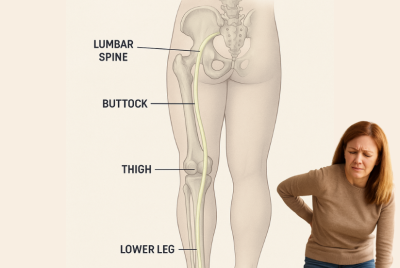Essential Oils for Sciatica Pain
Natural Relief for Nerve Pain
Discover the best essential oils for sciatica pain relief. Learn how to use them for natural pain management and muscle relaxation. Sciatica is a common condition characterized by pain that radiates along the sciatic nerve, typically affecting the lower back, hips, and legs. It can be caused by herniated discs, spinal stenosis, or muscle tightness compressing the nerve. While conventional treatments like pain relievers and physical therapy can help, many people seek natural alternatives such as essential oils to ease discomfort and promote healing. Essential oils have been used for centuries to relieve pain, reduce inflammation, and promote relaxation. In this guide, we will explore the best essential oils for sciatica pain, how they work, and the most effective ways to use them for relief.
Best Essential Oils for Sciatica Pain Relief
1. Peppermint Oil
Why it works:
- It contains menthol, which has cooling and analgesic properties.
- It helps reduce nerve pain and muscle spasms.
- Improves blood circulation, promoting healing.
How to use: Mix 5 drops of peppermint oil with 1 tablespoon of carrier oil (coconut or almond oil) and massage into the affected area.
2. Lavender Oil
Why it works:
- Known for its calming and anti-inflammatory properties.
- It helps relax tense muscles that may be aggravating sciatic nerve pain.
- Reduces stress and improves sleep, which can aid recovery.
How to use: Add a few drops to a warm bath or diffuse it before bedtime for relaxation and pain relief.
3. Eucalyptus Oil
Why it works:
- Has anti-inflammatory and analgesic effects.
- It provides a cooling sensation that can ease nerve pain.
- It improves oxygen flow, helping with muscle and nerve function.
How to use: Mix with a carrier oil and apply to the lower back or use in a steam inhalation to promote overall relaxation.
4. Helichrysum Oil
Why it works:
- It is known for its powerful pain-relieving and anti-inflammatory properties.
- It aids in nerve regeneration, making it beneficial for sciatica pain relief.
How to use: Dilute with a carrier oil and massage gently into the affected area for targeted pain relief.
5. Ginger Oil
Why it works:
- It improves circulation and reduces muscle stiffness.
- It contains natural anti-inflammatory compounds that help with sciatic nerve irritation.
How to use: Apply a diluted mixture to the lower back and legs or add to a warm compress.
6. Rosemary Oil
Why it works:
- Stimulates circulation and reduces inflammation.
- It helps with muscle relaxation, which can relieve pressure on the sciatic nerve.
How to use: Blend with a carrier oil and massage into sore muscles or add to a warm bath.
7. Chamomile Oil
Why it works:
- Has natural calming and anti-inflammatory effects.
- It helps ease nerve pain and tension in the muscles.
How to use: Use in massage therapy or add a few drops to tea for internal relaxation.
How to Use Essential Oils for Sciatica Pain
1. Massage Therapy
Mix 5-10 drops of your chosen essential oil with 1-2 tablespoons of carrier oil and massage into the lower back, hips, and legs. This helps reduce tension, improve circulation, and promote relaxation.
2. Aromatherapy Diffusion
Use an essential oil diffuser to inhale the therapeutic benefits of oils like lavender, eucalyptus, or chamomile. This method helps reduce stress and promotes overall relaxation, which can alleviate pain.
3. Warm Compress
Add a few drops of essential oil to a warm, damp towel and apply it to the affected area. The heat enhances absorption and helps relax tight muscles.
4. Bath Soak
Add 10-15 drops of essential oil to a warm bath with Epsom salt. This combination helps relax muscles, reduce inflammation, and provide overall pain relief.
5. DIY Essential Oil Pain Relief Blend
Combine the following oils for an effective sciatic pain relief blend:
- 5 drops peppermint oil
- 5 drops of lavender oil
- 5 drops of eucalyptus oil
- 2 tablespoons carrier oil (coconut, almond, or jojoba oil)
Massage this blend into the lower back and legs for relief.
Additional Natural Remedies for Sciatica Pain
While essential oils can provide relief, incorporating other natural remedies can enhance results:
1. Stretching & Yoga
Gentle yoga stretches like the pigeon pose or knee-to-chest stretch can help release tension in the lower back and hips.
2. Cold & Heat Therapy
Applying a cold pack to reduce inflammation, followed by a warm compress, can help relieve pain.
3. Anti-Inflammatory Diet
Eating foods rich in omega-3 fatty acids, turmeric, and leafy greens can help reduce inflammation and support nerve health.
4. Proper Posture & Ergonomics
Maintaining good posture and using ergonomic chairs can prevent further nerve compression.
FAQs Related to Essential Oils for Sciatica Pain
1. Can essential oils cure sciatica permanently?
Essential oils can help manage symptoms, but they do not provide a permanent cure. A combination of treatments, including physical therapy and lifestyle changes, is recommended.
2. How long does it take for essential oils to relieve sciatic pain?
Relief can be felt within minutes to hours, depending on the method of application. Consistent use over days or weeks may provide long-term benefits.
3. Are there any side effects of using essential oils for sciatica?
Some people may experience skin irritation or allergic reactions. Always perform a patch test before using a new oil.
4. Can I use essential oils while taking medication for sciatica?
Yes, but consult your doctor to ensure there are no interactions between essential oils and your medications.
5. What is the best way to apply essential oils for sciatic pain relief?
Massage therapy and warm compresses are the most effective methods for targeted relief.
6. Can I mix multiple essential oils for better results?
Yes, blending essential oils like peppermint, lavender, and eucalyptus can enhance their pain-relieving effects.
7. Are essential oils safe for pregnant women with sciatica?
Some essential oils should be avoided during pregnancy. Consult a healthcare professional before using any essential oils.
Essential Oils for Sciatica Pain – Conclusion
Essential oils provide a natural, effective way to manage sciatica pain by reducing inflammation, relaxing muscles, and promoting circulation. Oils like peppermint, lavender, eucalyptus, and ginger offer targeted relief when used through massage, baths, or aromatherapy. For best results, combine essential oils with lifestyle changes like stretching, proper posture, and a healthy diet. If sciatica pain persists or worsens, consult a healthcare professional for a comprehensive treatment plan. By incorporating essential oils into your self-care routine, you can find relief and improve your overall well-being naturally.
Disclaimer
Please note that this article should not replace professional medical advice. Consult a healthcare professional for an accurate diagnosis and tailored treatment plan.






